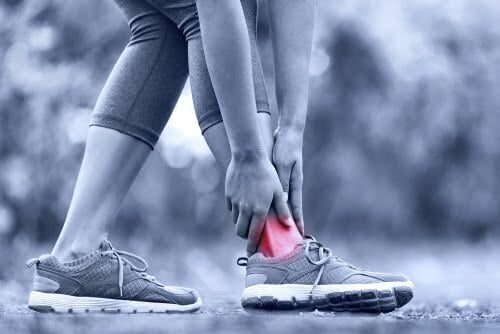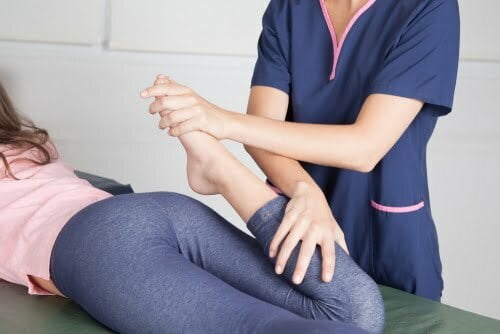
Acute injuries can suddenly occur during various kinds of physical activity when soft tissue damage occurs in your body, impacting the muscles, tendons, and ligaments. While an acute injury can happen during sports and exercise activities, it can result from everyday activities.
Sprains and strains, like a sprained ankle or strained muscle, are the most common acute injuries that individuals experience. It’s important to seek Physiotherapy treatment as soon as possible and begin treatment to promote faster recovery for the affected body part.
Common Injuries
The Cause
An acute injury results from physical activity and is caused by a specific event, such as falling, twisting, landing awkwardly, or a blow to the body. The pain that results from these events often causes pain in the impacted body part.
Sprains
A sprain is a stretch or tear of the ligament, a strong band of connective tissue that connects one bone to the other. Ligaments in your body are vital in stabilizing and supporting the joints.
A sprained ankle, knee, or wrist are some of the most common sprains, as they are some of the most vulnerable body parts. For example, a sprained ankle can occur when your foot twists inward awkwardly, which puts extreme pressure on the ligaments of your outer ankle. Knees can become sprained by twisting suddenly, and a wrist sprain can result from falling with your hand outstretched.
Sprains are often classified by how severe they are:
- Grade 1 Sprain (Mild): Slight damage to the fibers of the ligament.
- Grade 2 Sprain (Moderate): Partial tearing and looseness of the ligament.
- Grade 3 Sprain (Severe): Complete tear in the ligament.
The pain associated with sprains can vary. Most people can experience discomfort, swelling, inflammation, and bruising in the affected body part.
Strains
A strain is an injury to the muscle or tendon. Tendons are fibrous cords of tissue that are attached to the muscle to the bones. The most common strains occur in the back of the leg, specifically the hamstring.
Strains may either result from an overextended muscle or tendon or involve a partial or complete tear. Patients often feel pain, muscle spasms, muscle weakness, cramping, swelling, and inflammation.
Intense sports, such as football, soccer, hockey, wrestling, or any other contact sports can put people at risk of hamstring strains.
Symptoms
An acute injury results in damage to soft tissue and while this can include muscles, tendons, or ligaments, you may also experience further damage to the skin, cartilage, fascia, bones, and nerves.
When dealing with an acute injury, you may experience:
- Localized pain.
- Swelling and inflammation.
- Limited range of motion.
- Decreased function.
- Redness or bruising.
There are reasons why these symptoms will suddenly appear after an injury, such as:
- Microscopic damage to small blood vessels and connective tissue can result from twisting, tearing, or blunt force trauma.
- The microscopic damage can lead to blood, plasma, or cellular fluid leaking into nearby tissues in the body.
- The leaking fluid and other chemical mediators or dilation of blood vessels can cause swelling.
- Once the blood begins to move toward the surface of the skin, the skin turns blue, black, or red as bruising forms.
- The pain that you feel results from the collection of fluid, chemicals released into the body, and lowered oxygen levels in your soft tissue.

Treatment
As you begin to feel pain and discomfort in the injured area limb, it’s important to start treating it as soon as possible.
The P.R.I.C.E. Method
The protection, rest, ice, compression, and elevation (P.R.I.C.E.) method is a variation of the traditional R.I.C.E. with the addition of protection.
- Protection: Is meant to prevent further injury by using a sling, splint, or brace to immobilize the injured area and limit your movement. Some common braces include a walking cast, wrist splint, ankle brace, knee brace, or casts.
- Rest: Avoid exercising and decrease your physical activity as much as possible. You can use crutches if you can’t put weight on your ankle or knee, or a sling for your shoulder.
- Ice: The use of cold treatments to treat acute injuries. Ice is often recommended to minimize swelling and decrease pain for the healing process to continue. Take a plastic bag filled with crushed ice and apply it to the injured area in cycles of 10-15 minutes, every hour or two.
- Compression: Use a compression wrap, such as an elastic bandage, to provide support to the injured limb and minimize tissue damage or inflammation.
- Elevation: Swelling can increase as fluids collect in the injured area. Keeping the injured area elevated above its resting position can minimize swelling.
Physiotherapy
People dealing with acute injuries may benefit from pain relief and recovery from Physiotherapy treatment. Some Physiotherapy treatments may include massage, manipulation, and exercises to improve range of motion and strengthen muscles so you can return your limb to its normal function.
Other Treatment Methods
Some acute injury treatment methods that you may use include the following:
- An exercise program.
- A return to work/sports plan.
- Manual therapy to minimize pain and swelling.
- Anti-inflammatory electrical modalities, such as ultrasound, laser therapy, or interferential current (IFC).
- Acupuncture.
- Bracing, splinting or taping.
- Ice treatment.
For acute injury treatment, book an appointment at our Winnipeg physiotherapy clinic. We have licensed Physiotherapists that can provide a variety of treatment options to help you find pain relief and return to your daily living. No matter how painful your injury may be, we strive to ensure the recovery process moves as effectively and efficiently as possible.



